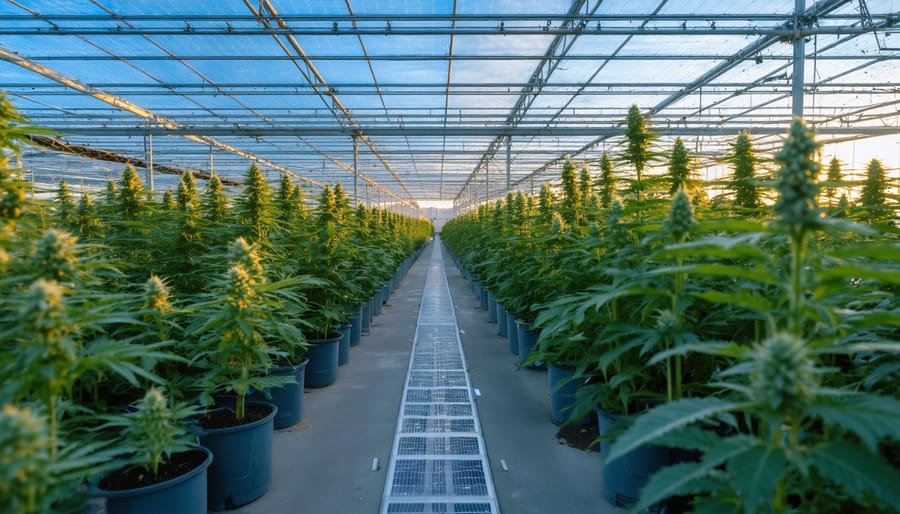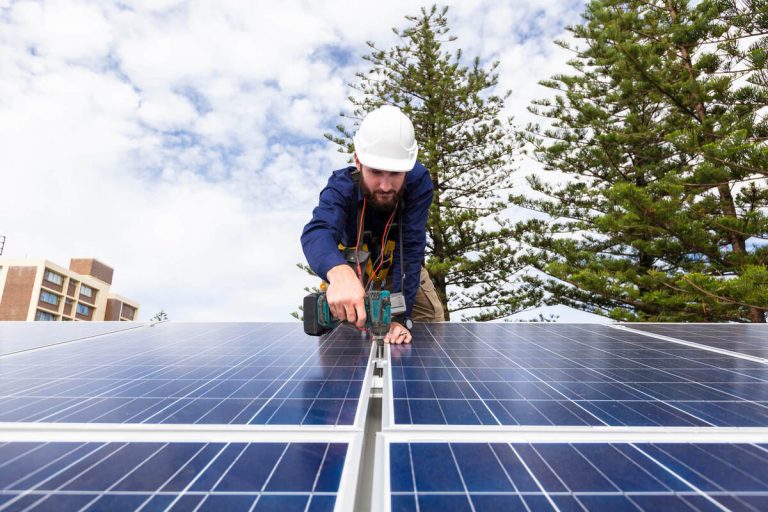Delta 9 THC cannabis cultivation demands extraordinary energy—up to 2,000 kilowatt-hours per pound of flower—making electricity costs one of the largest expenses for growers. Indoor operations require constant lighting, climate control, dehumidification, and ventilation to produce premium yields, creating energy bills that can consume 30-50% of operational budgets.
**Harness sunlight to power your grow operation.** Installing solar panels specifically sized for cannabis cultivation typically reduces energy costs by 50-75% while protecting against rising utility rates. For a medium-scale indoor operation using 50,000 kWh annually, solar systems pay for themselves within 5-7 years through energy savings alone.
**Match your solar capacity to cultivation intensity.** Calculate your grow room’s power requirements—including HID or LED lighting (typically 600-1000 watts per plant), HVAC systems, and circulation fans—then size your solar array to cover 80-100% of this demand. Home growers with 4-6 plants need approximately 3-5 kW systems, while commercial operations require 25-100+ kW installations.
**Leverage federal and state incentives immediately.** The federal Investment Tax Credit currently covers 30% of solar installation costs, while many states offer additional rebates and net metering programs that credit excess solar production back to your account. These incentives dramatically improve return on investment.
The convergence of cannabis legalization and renewable energy creates unprecedented opportunity. Solar energy offers growers economic resilience, environmental responsibility, and community leadership in sustainable agriculture—transforming energy-intensive cultivation into a model for regenerative business practices.
Why Cannabis Cultivation Demands So Much Energy
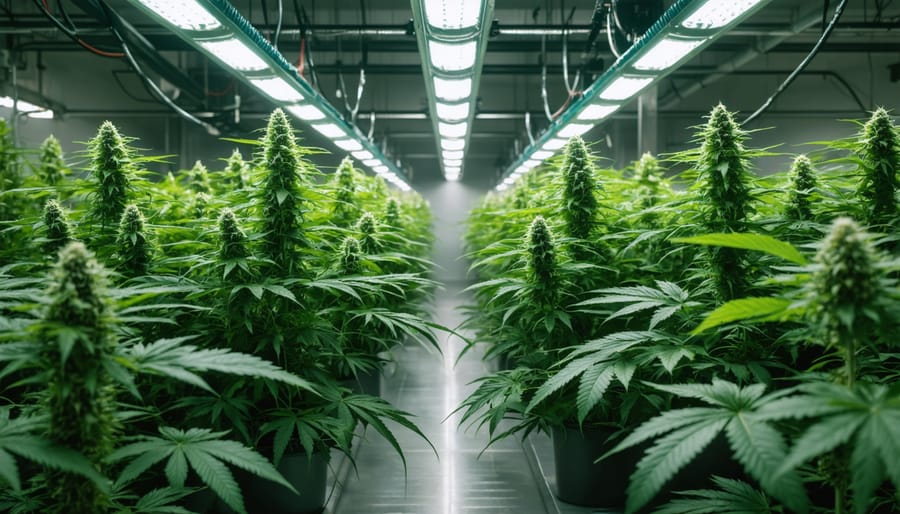
Understanding Delta-9 THC and Growing Requirements
Delta-9 tetrahydrocannabinol, commonly known as Delta-9 THC, is the primary compound in cannabis responsible for its therapeutic and psychoactive properties. For both home cultivators and commercial growers, producing high-quality cannabis rich in Delta-9 THC isn’t simply about planting seeds and waiting for harvest—it requires creating an environment that mimics the plant’s ideal natural conditions with remarkable precision.
Cannabis plants are particularly sensitive to their surroundings. To maximize Delta-9 THC production, growers must carefully regulate temperature, humidity, light intensity, and air circulation throughout the plant’s lifecycle. Indoor cultivation facilities typically maintain temperatures between 70-85°F during growth phases, with humidity levels adjusted from 60% in early stages to 40% during flowering. The lighting demands are especially significant: cannabis requires intense illumination for 12-18 hours daily, depending on growth stage.
These exacting requirements translate into substantial energy consumption. Climate control systems run continuously to maintain stable conditions, while high-intensity grow lights—often the largest energy draw—operate for extended periods. Ventilation systems work constantly to manage heat and humidity, and dehumidifiers prevent moisture-related issues that could compromise plant health and potency.
This energy-intensive reality has made cannabis cultivation one of the most power-hungry agricultural practices. As more communities embrace legal cannabis production, the environmental impact has sparked important conversations about sustainable growing practices, making renewable energy solutions like solar power increasingly attractive and necessary.
The Real Cost of Traditional Energy for Indoor Growing
Growing cannabis indoors comes with an energy bill that surprises many first-time cultivators. Whether you’re tending a few plants at home or managing a commercial operation, the electricity costs can quickly overshadow other expenses.
For a small home setup with just four plants, growers typically run high-intensity grow lights for 12-18 hours daily, along with ventilation fans, dehumidifiers, and climate control systems. This setup can consume 1,000-2,000 kilowatt-hours per month—roughly equivalent to adding two or three refrigerators running continuously. At average electricity rates, that translates to $150-$300 monthly, or up to $3,600 annually. For hobbyist growers, these costs often exceed the value of their harvest.
Commercial operations face even steeper challenges. A mid-sized facility might consume 200,000 kilowatt-hours monthly, resulting in electricity bills exceeding $20,000. For many businesses, energy represents 30-50% of total operating costs, making it the largest controllable expense after labor.
These numbers become particularly concerning in regions with higher electricity rates or during peak demand periods when utility companies charge premium prices. Summer months can be especially brutal, as cooling systems work overtime to maintain ideal growing temperatures.
Beyond the financial impact, traditional grid electricity carries an environmental footprint. Cannabis cultivation accounts for an estimated 1% of total U.S. electricity consumption, equivalent to powering 1.7 million homes. For growers committed to sustainable practices and community-minded cultivation, this energy dependence creates a disconnect between their environmental values and their operational reality.
Understanding these costs reveals why so many growers—from backyard enthusiasts to licensed producers—are exploring renewable alternatives that align profit margins with environmental responsibility.
Solar Power: The Natural Fit for Cannabis Cultivation
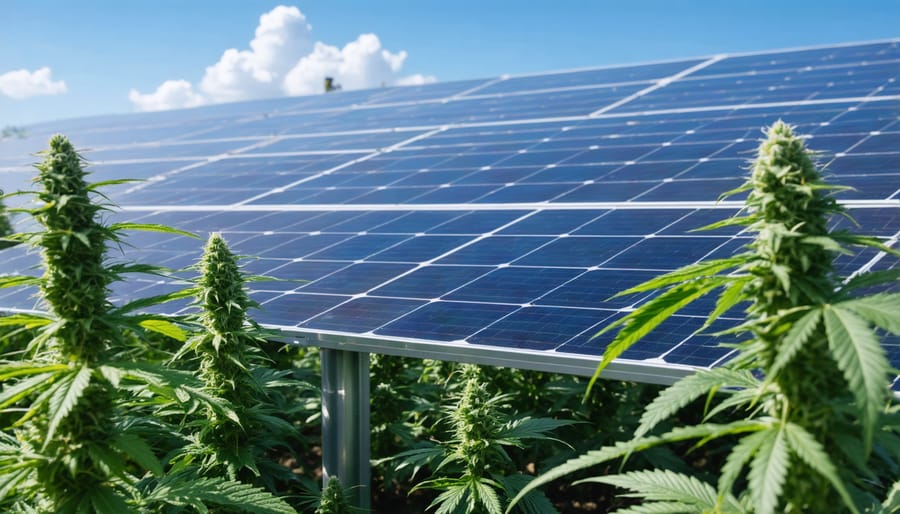
Reducing Operating Costs While Supporting Sustainability
Switching to solar power offers cannabis cultivators a powerful way to slash operating costs while building a more sustainable business model. Energy expenses typically represent 30-50% of total operational costs for indoor cannabis operations, making electricity bills one of the largest ongoing challenges growers face. Solar installations can reduce these energy costs by 50-90%, creating immediate and lasting financial relief.
Consider Maria, a small-scale cannabis grower in Colorado who installed a 15-kilowatt solar array on her cultivation facility. Within the first year, she saw her monthly electricity bills drop from $2,800 to just $450—a savings of over $28,000 annually. “The predictability alone has transformed my business planning,” Maria explains. “I’m no longer anxious about peak summer cooling costs or unexpected rate increases.”
The return on investment for solar systems in cannabis cultivation typically ranges from 3-7 years, depending on location, system size, and available incentives. After this payback period, growers essentially enjoy free electricity for the remaining lifespan of their panels—usually 25-30 years. This long-term perspective makes solar particularly attractive for operations planning to establish roots in their community.
Commercial cultivators report even more dramatic results. A California-based operation with a 200-kilowatt system now generates approximately 85% of their facility’s power needs, saving over $180,000 annually. These savings can be reinvested into better equipment, employee wages, or community initiatives—creating a ripple effect of positive impact.
Beyond direct savings, solar-powered facilities often qualify for reduced insurance premiums and enhanced property values, adding additional layers of financial benefit. The combination of immediate cost reduction and long-term energy independence makes solar an increasingly practical choice for cultivators committed to sustainable, economically resilient operations.
Environmental Benefits That Matter to Your Community
Choosing solar power for cannabis cultivation sends a powerful message to your community about environmental responsibility. Indoor cannabis operations traditionally consume as much energy as small manufacturing facilities, but switching to solar dramatically reduces greenhouse gas emissions—often by 75% or more compared to grid-dependent operations.
This shift matters beyond your property line. As communities nationwide set ambitious climate goals, solar-powered cannabis businesses become partners in reaching those targets rather than obstacles. Local governments increasingly recognize sustainable cultivation operations as responsible neighbors, which can smooth licensing processes and build public support.
The environmental benefits are tangible and measurable. A medium-sized solar installation powering a cannabis grow operation prevents approximately 100 tons of carbon dioxide emissions annually—equivalent to planting 1,600 trees or taking 20 cars off the road. These numbers resonate with environmentally conscious neighbors and demonstrate your commitment to shared community values.
Beyond emissions reduction, solar-powered cultivation operations often inspire broader sustainability practices. Many growers find that investing in solar naturally leads to implementing water conservation systems, composting programs, and other green initiatives that further benefit the local environment.
As cannabis cultivation becomes more accepted nationwide, communities increasingly judge operations by their environmental footprint. Embracing solar positions your cultivation practice as forward-thinking and community-minded, helping shift public perception while protecting the environment future generations will inherit.
Getting Started: Solar Solutions for Different Scale Operations
Small-Scale Home Growing: What You Need to Know
Growing cannabis at home for personal use doesn’t require industrial-scale infrastructure, but you’ll still need careful planning to power your cultivation sustainably. A typical home grow operation—supporting 4-6 plants under LED lights—consumes approximately 300-500 kilowatt-hours monthly, comparable to adding a second refrigerator to your household energy load.
Understanding your solar system requirements starts with assessing your grow setup’s energy demands. Growing lights, ventilation fans, dehumidifiers, and climate control systems all contribute to your electricity consumption. Most home cultivators can offset their growing operation with a modest 2-4 kilowatt solar array, which fits comfortably on a typical residential rooftop.
The typical costs for a system this size range from $6,000 to $12,000 before incentives. However, the federal Investment Tax Credit currently covers 30% of installation expenses, and many states offer additional rebates specifically for residential solar projects. Some utility companies provide net metering programs, allowing you to sell excess solar energy back to the grid during non-growing seasons.
Beyond financial benefits, home solar cultivation aligns with the values many cannabis enthusiasts embrace—sustainability, self-sufficiency, and environmental stewardship. Your investment pays dividends through reduced electricity bills while supporting a cleaner energy future. Many homeowners discover their solar system generates enough surplus energy to power other household needs, making the entire home more sustainable.
Commercial Operations: Scaling Solar for Larger Facilities
For commercial cannabis operations, scaling up to solar power represents a transformative business decision that goes far beyond simple energy savings. Large cultivation facilities consume enormous amounts of electricity—often comparable to small manufacturing plants—making them ideal candidates for substantial solar installations that can dramatically reduce operational costs while strengthening your brand’s commitment to sustainability.
Commercial-scale solar systems typically range from 100kW to several megawatts, depending on your facility size and energy needs. These systems can offset 50-80% of your electricity consumption, translating to significant monthly savings that accumulate into hundreds of thousands of dollars over the system’s lifetime. Many commercial growers report achieving payback periods of 5-7 years, after which they enjoy decades of reduced energy expenses.
Battery storage becomes particularly valuable at the commercial level, providing protection against grid outages that could jeopardize entire harvests. Modern battery systems can keep critical operations running during power disruptions while also allowing you to store excess solar energy for use during expensive peak-demand hours. This strategic energy management can further reduce utility bills by 20-30%.
Grid integration with proper planning and expertise ensures your facility operates seamlessly, drawing from solar during the day and supplementing with stored or grid power as needed. Many commercial operators also benefit from net metering policies, earning credits for excess solar energy sent back to the grid.
Beyond financial returns, solar investments demonstrate environmental leadership to consumers, investors, and regulators—increasingly important as the cannabis industry matures and sustainability becomes a competitive differentiator.
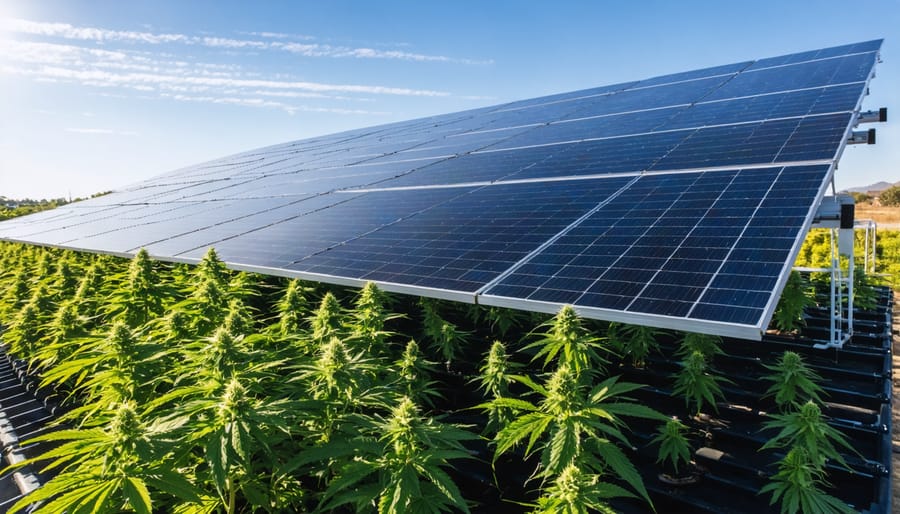
Incentives, Policies, and the Path Forward
Federal and State Incentives for Solar Adoption
Cannabis cultivators can tap into substantial financial benefits through federal and state solar incentives, making solar adoption increasingly accessible even within this unique industry. The federal Investment Tax Credit (ITC) currently offers a 30% tax credit on solar installation costs, representing significant savings for growers investing in renewable energy infrastructure.
While cannabis businesses face banking and tax challenges due to federal classification, solar incentives remain available because they apply to property improvements rather than plant-touching activities. Many growers successfully claim these benefits by structuring their solar investments as separate business entities or real estate improvements.
State-level programs add another layer of opportunity. Net metering policies in many states allow excess solar energy to be credited back to your utility account—particularly valuable for cannabis operations with round-the-clock energy demands. Some states offer additional rebates, grants, or accelerated depreciation schedules that further improve return on investment.
Local utility companies often provide incentives for commercial solar installations, including performance-based payments and demand charge reductions. These community-driven programs recognize solar energy’s role in grid stability and sustainability goals.
Working with experienced solar providers familiar with cannabis cultivation ensures you navigate available incentives effectively. Despite industry-specific complexities, the financial case for solar grows stronger as energy costs rise and sustainability becomes increasingly important to consumers and policymakers alike. The path to cleaner, more affordable power is open—taking advantage of these opportunities positions your operation for long-term success.
Advocating for Supportive Energy Policies
Individual voices matter, but collective action creates lasting change. As both solar energy and cannabis cultivation evolve, your participation in community discussions can help shape policies that support sustainable practices. Attend local town halls, engage with regional planning committees, and share your experiences with solar-powered growing operations—whether you’re a homeowner experimenting with personal cultivation or operating at a larger scale.
When communities speak up about the benefits they’ve experienced—reduced energy costs, cleaner air, job creation in renewable sectors—policymakers gain real-world data to inform balanced decisions. Consider joining or forming grower networks focused on sustainability, where members exchange knowledge about effective solar implementations and collectively advocate for supportive frameworks.
Your story about transitioning to solar power can inspire neighbors and influence decision-makers regardless of political affiliation. Focus conversations on shared values: energy independence, environmental stewardship, and economic resilience. By emphasizing these universal benefits, you help create an environment where sustainable cannabis cultivation and renewable energy adoption can thrive together, supported by policies that reflect community priorities and proven outcomes rather than partisan divides.
Embracing solar power for your cannabis cultivation operation isn’t just a smart business decision—it’s an investment in a sustainable future that benefits your bottom line and the planet. The economic advantages are clear: reduced electricity bills, protection from rising energy costs, and attractive incentives that make solar more accessible than ever. But beyond the financial savings, choosing solar positions you as part of a growing community of cultivators who recognize their responsibility to minimize environmental impact while producing quality cannabis.
Whether you’re a home grower managing a few plants or operating a commercial facility, solar technology has evolved to meet your specific needs. The beauty of this transition lies in its flexibility—you can start small and expand as your operation grows, making it achievable for cultivators at every level.
As more growers adopt renewable energy, they’re collectively shifting industry standards and influencing policy makers to support sustainable agriculture practices. This community-driven movement demonstrates that cannabis cultivation and environmental stewardship can go hand in hand, challenging outdated perceptions and paving the way for greener regulations.
The path forward is illuminated by the sun itself. By exploring solar options today, you’re not just cutting costs—you’re joining a forward-thinking community that proves profitable cultivation and planetary care aren’t mutually exclusive. Your choice to go solar ripples outward, inspiring others and contributing to a cleaner, more sustainable future for everyone.

